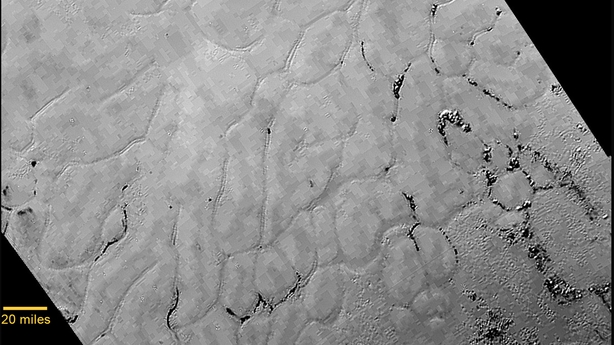NASA has released more images of Pluto three days after the spacecraft New Horizons flew by the planet.
The unveiling was broadcast revealing clear images of the planet.
Mountains and canyons were seen on the largest of its five moons.

The ice mountains on Pluto are considered to be the size to some of the smaller Rocky Mountains and may be up to 9kms deep and may still be geologically active.
The spacecraft is the first to encounter the dwarf planet, after a nine year, five billion kilometre journey.
The latest data includes a new close-up image of a large craterless plain that scientists have named Sputnik Plain after Earth's first satellite, which is made up of a cracked surface of irregular shaped pieces around 20 kilometres wide with troughs around them.
Some of those troughs have a strange black material in them.
Scientists say the plain appears to be no more than 100 million years old, and is possibly still being shaped by geologic processes beneath or around it.
The region, which scientists say they cannot easily explain, is situated north of the icy mountains identified on Wednesday, in the center-left of the heart feature informally named the Tombaugh Region after Clyde Tombaugh, who discovered Pluto in 1930.
In other areas the surface appears to have areas of small pits that may have formed by a process called sublimation, in which ice turns directly from solid to gas.
Scientists say there is also evidence of a wind blowing across the icy surface, with streaks several miles long aligned in the same direction evident.
The scientists also released further data about Pluto's nitrogen rich atmosphere which is leaking into space and found a region of cold, dense ionized gas tens of thousands of miles beyond Pluto which they believe is its atmosphere being stripped away by the solar wind.
They also released fly over images of the dwarf planet's mountainous surface, which shows peaks which could be as high as the Rocky Mountains.
Because of its distance from Earth and low power, New Horizons can only feed its treasure trove of data back very slowly.
Scientists say 50GB was captured in recent days, and it will take 16 months for it all to be returned to Earth.

